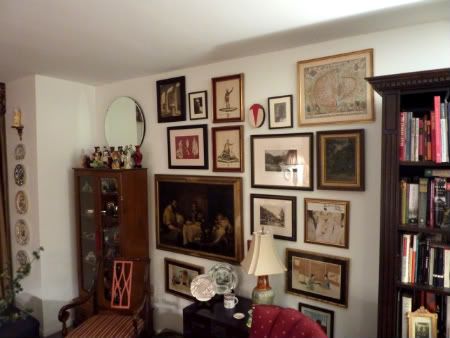Antique Desire
The Antique Flaneur in London
by Kelly Keating on 10/02/11

A view of Big Ben from Trafalgar Square.
I recently returned from a fabulous trip to London which combined both business and pleasure. The main reason for my trip was to attend my dearest friend's wedding where I officiated the ceremony. She and I have been friends for over 30 years. It was a spectacular and beautiful event.
After the wedding, I had a week to journey around London and also look for antique items for clients as well as my own collection. On this trip I decided to focus my sightseeing on visiting historic homes. The first home I visited was Marble Hill House, a neo-Palladian villa on The Thames, that was built from 1724-1729 for Henrietta Howard, Duchess of Suffolk, who had been a mistress of George II when he was Prince of Wales. The house was filled with some gorgeous items including a set of Chinese export chairs in padouk and rosewood and Chinese enamelled paintings on glass.

Marble Hill House
I next visited Chiswick House, another neo-Palladian villa, that was designed by Lord Burlington (1694-1753), its owner, and William Kent (1685-1748), an architect, landscape architect and furniture designer. The house was completed in 1729. It is an architectural jewel. The lavish interior is filled with furniture designed by Kent as well as sumptuous paintings. The house is located within a beautiful landscape laid out by Kent and is one of the first examples of the English landscape garden. It really is a pleasure palace.
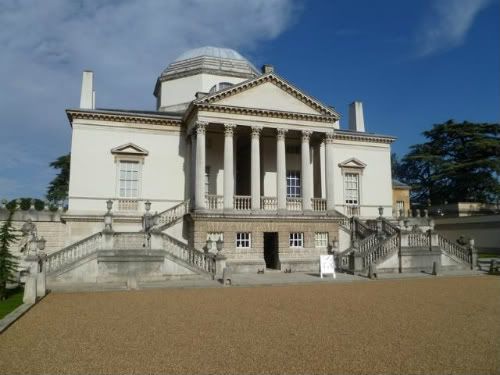
Chiswick House
A few days after visiting Chiswick House, I went to see Horace Walpole's (1717-1797) neo-Gothic villa, Strawberry Hill House, which has been recently restored. The building of the house began in 1750. Walpole was the youngest son of the first British Prime Minister Robert Walpole. He was an art historian, a man of letters, and a Whig politician. Today, he is most remembered for Strawberry Hill House which he designed and built along with his so-called Committee of Taste comprised of the connoisseur and amateur architect John Chute and the draftsman and designer Richard Bentley. The Gothic style of the villa is in part important for its appearance long before the re-emergence of the Gothic style during the historicsim craze of the Victorian period.

Strawberry Hill House, river facade
The interior of the house is also decorated in the Gothic style. Walpole took elements from Gothic structures such as cathedrals and tombs to design the architectural features in the house such as the ceilings, fireplaces, windows, mouldings and so on.

The Tribune Room at Strawberry Hill where Walpole kept his most valuable treasures.
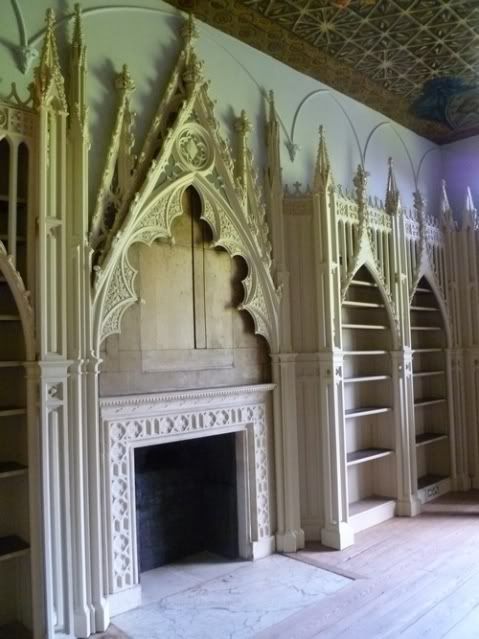
The Library at Strawberry Hill
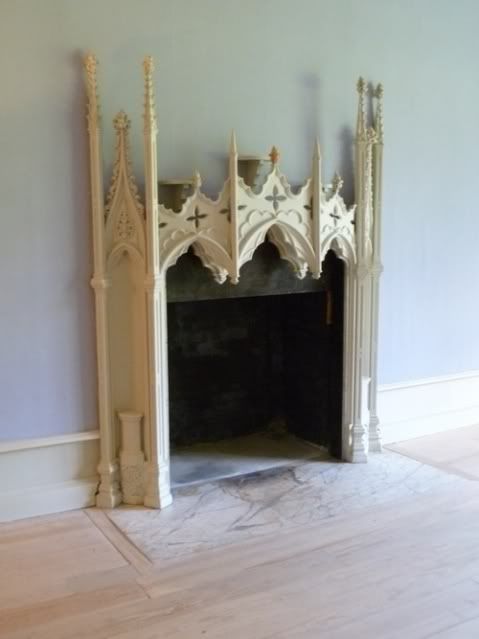
Dining room mantelpiece at Strawberry Hill
The house is also filled with beautiful stained glass of all sizes and subjects. The glass was both made for the house at the time of its construction as well as comprising earlier pieces acquired by Walpole.

Stained glass depicting Vanity at Strawberry Hill
Strawberry Hill is a magnificent house architecturally, but unfortunately it is relatively empty of Walpole's treasures. In 1842, the contents of the house were sold at auction in a sale that lasted 28 days. Hopefully, the continued restoration of the site will bring back some of the myriad of items that originally resided there. If you want to view Walpole's collection, there is a database at The Lewis Walpole Library at Yale University which "encompasses the entire range of art and artifacts of Walpole's collection."
The day after visiting Strawberry Hill, I journeyed east across London to the suburb of Bexleyheath to visit Danson House, yet another neo-Palladian villa, which was built circa 1764-67 by the famous architect Sir Robert Taylor (1714-1788) for the sugar merchant and vice chairman of the East India Company, Sir John Boyd (1718-1800).
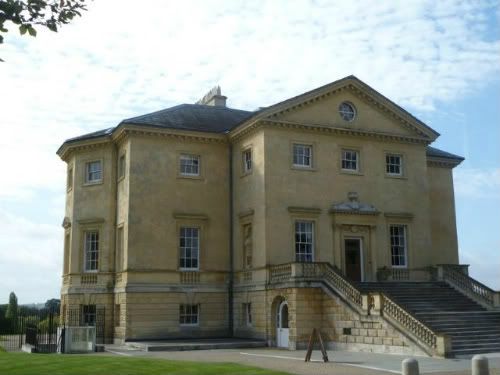
Danson House front entrance
Danson House is a small, but gorgeous building with three splendid and ornate reception rooms on the first floor: the dining room, an octogonal reception salon, and a gentlemen's library. My favorite room in the house is the dining room which has a series of inset paintings made onsite for the space by the French painter Charles Pavillon. The rococo style of the work is reminiscent of the paintings of Francois Boucher.
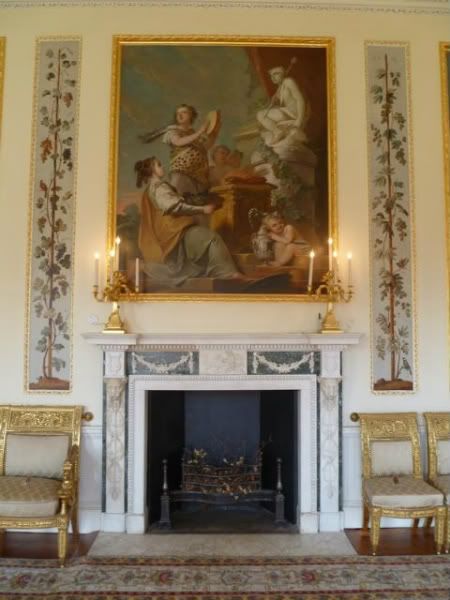
Dining room mantelpiece by William Chambers with "The Sacrifice to Bacchus" above by Charles Pavillon, Danson House.
Above the mantelpiece designed by the architect William Chambers (1723-1796) is Pavillon's painting "The Sacrifice to Bacchus". The statue of Bacchus in the image holds his traditional fennel staff topped with a pinecone- a thyrsus. The thyrsus motif is repeated in the vertical supports of the fireplace. Bacchus uses this staff to whip his female supplicants into a frenzy. The eroticism of this image directly relates to the owner of the house Sir John Boyd who married his second, much younger wife Catherine Chapone in 1766. It is a fitting image for a newly married couple. The other paintings in the dining room also relate to the marriage as does the decorations in the 2 other reception rooms which evoke a theme of love/eroticism to celebrate the marriage in the house that Sir John Boyd built for his new wife Catherine.
After touring these four intriquing and magnificent 18th century homes, I needed to do some antiquing for myself and for a client who was furnishing a gentleman's study. I first went to Gray's Antiques which is located off Bond Street in London. It is a multi-dealer establishment and if you are looking for a sublime piece of antique or vintage jewelry you are sure to find it there.
I went there to visit my friend Arnold of AMS Antiques Ltd. who has a superb collection of sterling and silverplate items. There, I found this lovely plate pierced creamer on a tripod base with paw feet and a hand-blown ruby glass liner. It is rare to find pieces like this with their original glass intact. The piece is unmarked, but probably dates to circa 1880-1900.
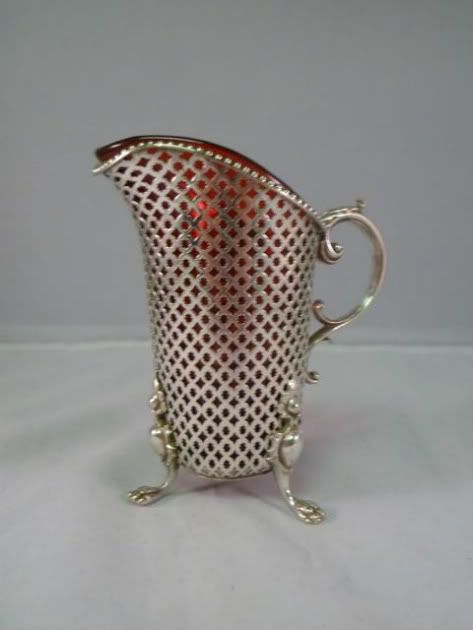
Several days later, I went to the Bermondsey Antique Market which is open every Friday starting at 4am! and ending around 1pm. It is located south of The Thames near the London Bridge Underground stop. It is a small market, but it is filled with quality items and friendly dealers. It is especially good for silver, both sterling and plate.
While there I found 2 impressive items for my client's library. The first was a late 19th century magnifying glass with an ivory handle and a brass holder for the glass. The piece was probably made circa 1880-1890 out of an older piece of ivory and a new magnifying glass. A perfect item for a library!
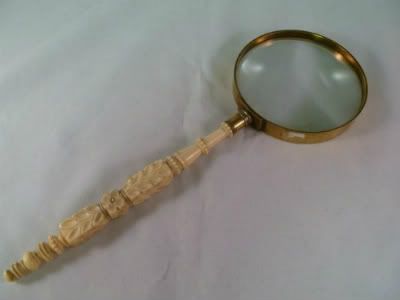
Next I found a mid-Victorian circa 1860-1870 burled walnut writing slope with brass fittings. The writing slope can be considered the laptop of the 19th century. This piece is in magnificent condition. It retains one of its original inkwells in its pristine mahogany interior. There are also 2 secret drawers behind a mahogany panel. It is a handsome piece that will "look the part" in my client's library. And of course, it is not merely decorative, but a usable item for writing notes and letters (admittedly a dying art) while one is reclining on the couch.

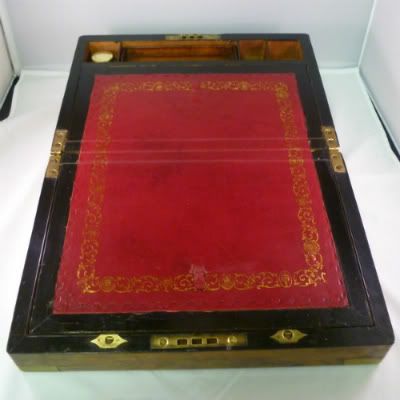
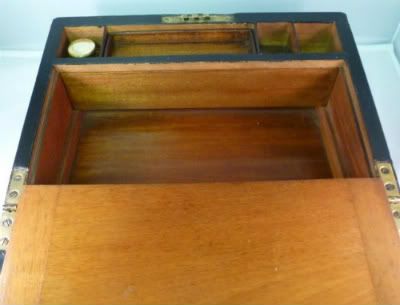
Finally at Bermondsey, I found 2 silver items for my own collection. The first piece is a sumptuous English sterling shell dish with reticulation and floral engraving. It was made in Sheffield by the respected maker Martin, Hall & Co. in 1899.
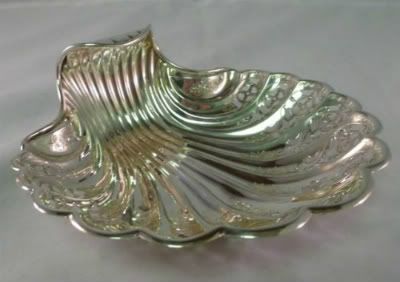
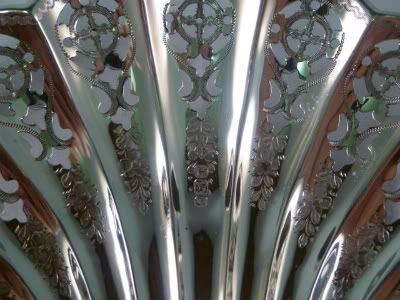
The second piece was a bit of a mystery. It is a French sterling sugar sifter or saupoudreuse with a beautifully pierced bowl of leaf sprigs and flowers. The dealer thought the ladle was late 19th century in date, but I had a hunch that it was earlier. Looking at the marks when I returned to New York, I determined the piece was actually made between 1824-1834. My colleagues at the SMPub silver site confirmed this date and determined the maker of the ladle to be Jean-Baptiste-Vast Harleux from Paris who was in business from 1824-1875. A fantastic find!
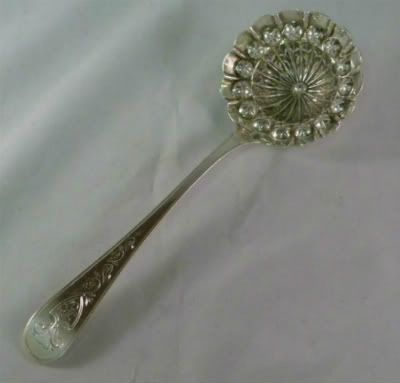
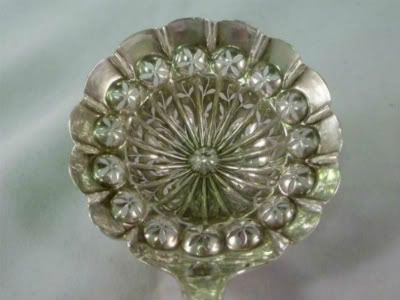
My trip to London wa a sublime experience filled with great joy and adventure- my dear friend got married, I saw beautiful 18th century homes and found some lovely antiques for a client and my own collection. I cannot wait to return!
If you are looking for an antique item, large or smal,l for your own collection or for a gift or perhaps you are an interior designer in need of an antique piece for a client, please contact me at [email protected] and visit my site www.theantiqueflaneur.com
Kelly T Keating
Mixing Old and New to Decorate Your Home
by Kelly Keating on 01/29/11
When decorating your home with antiques, it is often striking and more interesting to mix in newer pieces or combine antiques from different periods in order to create a more eclectic, collected and dynamic look. A room decorated all from one period, for example Louis XVI's France could be quite mesmerizing, a hallucinatory dream, but such a room is probably difficult and expensive to achieve. And even if realized, it could perhaps be too much of a single and atypical decorating note in our ahistorical, postmodern and everchanging world. Such a room would seem out of place and time as if it were a room in a museum or historic house rather than a comfortable home where people in the 21st century live and endure.
Instead, why not combine elements of 18th century French style and design with a pair of Phillipe Starck Ghost Chairs which although translucent (and also colored) polycarbonate, it is shaped like a Louis XV fauteuil. Or take a pair of 18th century French period chairs or a revival pair and cover them in a modern, bold, geometric fabric or even more intriguing, upholster them in an old burlap grain or feed sack with their great texture, neutral coloring and graphic lettering often in black. (The burlap sack French chair pictured below is for sale. Email me at [email protected] for more information.) Mixing old and new objects from accessories to furniture produces something unexpected and visually stimulating. Odd combinations create interesting spaces in which to live and endure in the 21st century world.
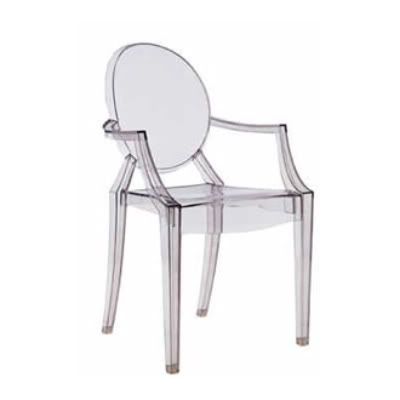
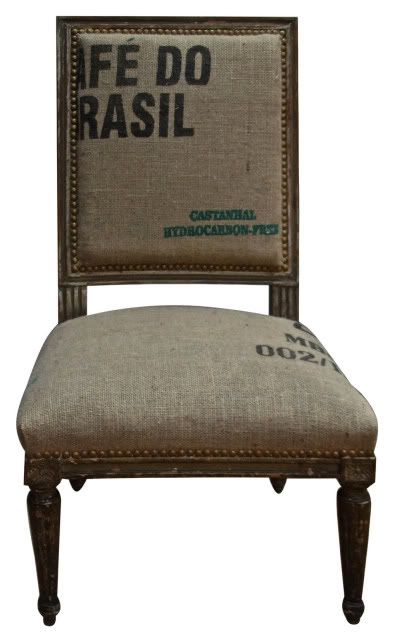
In my drawing room, for example, I have a 1930's/1940's English sideboard with gorgeous walnut veneers. On the sideboard is a pair of glass and gilt lamps. The glass portion of the lamp is decoupaged with chinoiserie figures, flowers and birds on a black background. These lamps were probably made as a craft project by an artistic someone in the 1940's or 1950's. Modern string shades in a neutral taupe color top the lamps and their texture provides a nice contrast to the smooth, opaque glass of the lamp body. A new, oval black stone finial set in a gold wire frame finishes the look and pulls the black of the lamp body up to the top of the piece.
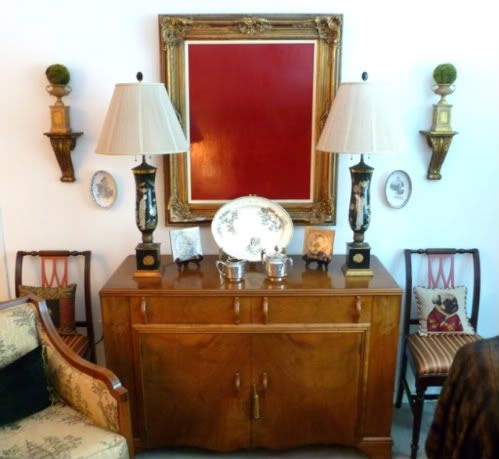
Hanging on the wall between the lamps is an old, massive, gilt and carved wood frame that my mother found in the trash more than 20 years ago. The frame adds a touch of luxe and over-the-topness to the room and compliments the gilt mounts of the lamps. To add some color to this vignette and the white walls of a rented apartment, I painted a canvas a deep crimson red with an enamel finish and simply placed it in the frame. It gives a bold, graphic and modern look that is in striking contrast to the traditional gold frame and its intricate carving. My red painting also serves to draw the red color of a nearby chair and the red in the rug to the midlevel area of the room.
Between the 2 lamps on the sideboard, I placed a large brown English Aesthetic transferware platter on a brass stand. The pattern is named Caius by George Jones & Sons, circa 1883. Notice the chrysanthemum motif and the pseudo-Japanese characters. Flanking the platter are a pair of American Aesthetic tiles c. 1880 by International Tile which was located in Brooklyn, New York. The pair of tiles are unusual examples of American pottery especially the one tile that depicts a group of Asian men in a humorous scene of a breaking cauldron. In front of the platter are a large 19th century silverplate sugar and creamer in an Aesthetic design by Rogers Smith & Co. circa 1877-1880. I enjoy this grouping of different Aesthetic objects on a contrasting sideboard that is more Deco in its inspiration.
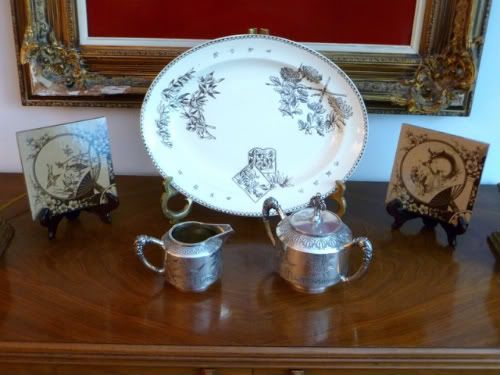
On the wall on either side of the large frame are a pair of Italian gilt wood shelves in a scroll design decorated with acanthus leaves. New molded gilt urns holding a moss ball are placed on each of the shelves. This touch of formalized nature is a pleasing contrast to the overall "culture" of the sideboard top vignette.
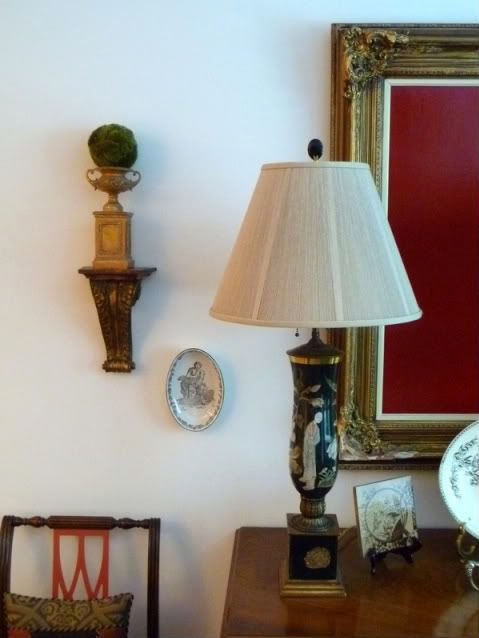
Below the shelves are a pair of black/white French? transferware plaques. One depicts a bird seller; the other depicts a basket seller. Each plaque surronds the center motif with a border of grapes and leaves. They are unmarked and probably mid-20th century in date. Their whimsical nature appeals to me. And their coloring and oval shape looks wonderful on the wall and pulls the black fabric of my Victorian fainting couch to that side of the room.

The entire tablescape on the sideboard in its disparate yet complementary elements creates a charming symmetrical composition in the drawing room, made up antique, vintage and new items. The aesthetic and visual joy lies in the mix of the scene.
A new client in California also achieves a wonderful look by mixing antique pieces with modern ones. In the dining nook of her kitchen, she has created a "pottery border" at the top of the wall using blue and white plates and platters in the traditional Willow pattern which was first designed by Thomas Minton in 1790 and has been copied by many other manufacturers since then and until today. What is so inspired about the decor of this eating area is the combination of 19th century blue and white pieces with modern Willow plates by the British artist Richard Dawson. Dawson takes elements of the orthodox Willow pattern and "sabotages" them- they are enlarged or cropped or reoriented to produce a new and dynamic transferware plate that is throughly modern, but rooted in a long enduring subject of the past. For example, in one plate the pair of birds usually a small motif in the original pattern are blown up to become the dominant and central subject of the plate. The border of this plate consists of magnified elements of the trees and a cropped portion of the geometric patterning on a 19th century Willow plate.




The "pottery border" creates a visually dynamic look that is heightened by the combination of antique and modern transferware. It is an inspired look that I will remember and "put" in my bag of tricks for future clients. Imagine a Welsh cupboard filled with traditional blue and white Willow plates and platters along with Mr. Dawson's "twisted" creations or as he refers to them- pieces of "aesthetic sabotage". Such an arrangement would produce a gorgeous and rich combination of old and new.
In my bedroom, I took an old maple highboy from the 1940's and had my friend who is an outstanding artist and decorative painter transform it into a piece of black and gold chinoiserie reminiscent of the 18th century. The transformation is extraordinary and it is perhaps my favorite piece of furniture in my home.
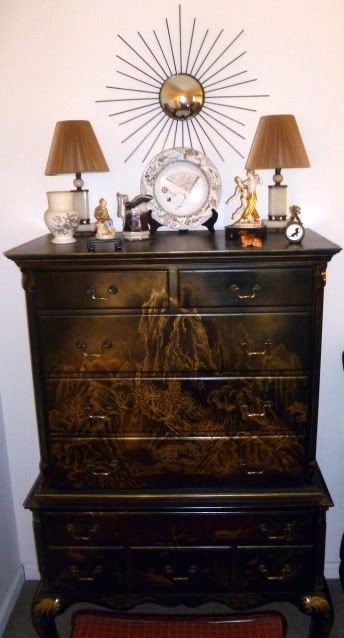
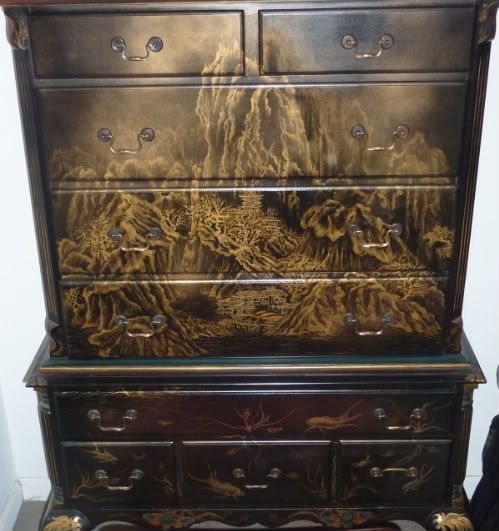
But how does one accessorize the top of a faux 18th century chinoiserie highboy? I used once again a mixture of old and new pieces to fashion an intriquing tablescape. The first element of this design is a pair of onyx footed lamps with gold metal fittings and new bronze colored string shades. Between the lamps I placed a large brown Aesthetic transferware soup bowl in the Jeddo pattern by Brown-Westhead Moore & Co. circa 1884. It's depiction of birds, Japanese fisherman and a central motif of a fan and ribbons complements the pagoda landscape of the highboy quite well.
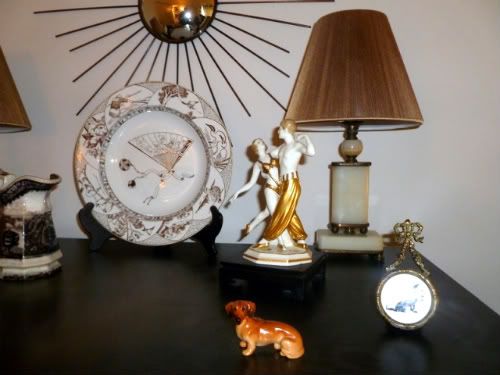
On the right side of the tablescape I placed an German Art Deco porcelain figurine of a dancing couple by Sitzendorfer circa 1920-1930 on a black square wooden stand for added height. The gold, creamy white and tan coloring of the figurine plays against the beige translucence of the onyx lamps and their bronze shades.
In front of the German Deco dancers, I put a Royal Doulton figurine of a dachshund which was a gift and a small round brass frame with garlands holding a silhouette image of a dachshund with what appears to be a crown in its mouth. This picture and frame was also a gift from friends who know my love of this breed and particularly of my dog Arthur, a red doxie.
On the left side of the tablescape is a small brown Aesthetic transferware vase. The pattern and maker are unknown, but the piece dates most likely to the 1880's. The vase complements the Jeddo soup plate and its bulbous shape is a good contrast to the rectangular shape of the lamps.
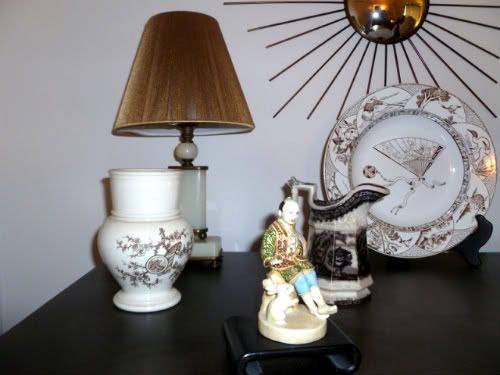
Accompanying the Aesthetic vase is an earlier 19th century black transferware octogonal shaped pitcher in the Washington Vase pattern by Podmore, Walker & Co. circa 1834-1859. In front of the small pitcher on a wood stand is an Occupied Japan (1945-52) porcelain figurine of an Asian man with 2 rabbits. The piece is marked: Handpainted, Lenwile China, Ardalt, Occupied Japan. It is unusual to find a porcelain Occupied Japan figurine and also one that is marked more than just Occupied Japan. Usually these figurines were made out of pottery and exported to the United States for sale in stores like Woolworth's where they cost around 35-45 cents and up per piece. The man with the 2 rabbits is a slightly higher grade of export. It complements the chinoiserie highboy and the Aesthetic transferware and provides a contrast to the German Deco figurine and the Doulton dachshund.
To complete my tablescape, I hung a decorative, modern sunburst concave mirror in a bronze finish that I bought rather cheaply at West Elm. Its circular shape mimics the Aesthetic soup plate, the profile of the Aesthetic vase, the string shades and the brass frame containing the dachshund silhouette. These round shapes are offset and punctuated by the verticals of the dancing couple and the man with rabbits figurine as well as the angular 8 sided shape of the black transferware pitcher and particularly in its squared off handle.
The chinoiserie highboy tablescape combines disparate elements in terms of period and style, but unites them through complementary and contrasting shapes, color and their artful placement. Most importantly, the mixing of antiques and modern pieces creates a strong visual vignette that delights me and hopefully any viewer of the highboy and intriques them with the subject and meaning of each individual piece.
If you need help combining your antique and modern pieces in a unique and decorative way, The Antique Flaneur can help you. I can fashion beautiful tablescapes in your home, be it on a sideboard, a dining room table, a china cabinet or a display vitrine. As always I am happy to find you a gorgeous antique to adorn your home, start a collection or add to one. Contact me at [email protected]. Also, if my painted highboy appeals to you, contact me for information about my friend who is an accomplished artist and superb decorative painter.
Kelly T Keating
The Antique Flaneur
Displaying Your Antique and Vintage Collections
by Kelly Keating on 01/01/11
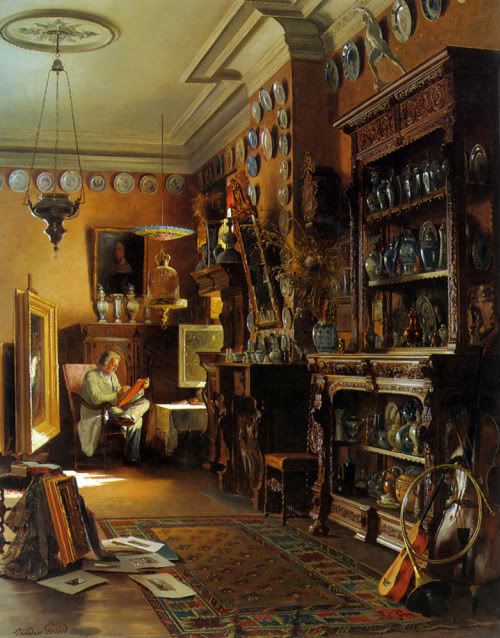
Theodore Gerard (1829-1895), The Collector's Studio
If you have a collection(s) of antique and vintage items, a central question is often how to display these treasures so that they will enhance your settting and provide visual enjoyment for you and also perhaps your guests. Yet, many times in a living room or dining room a collection is dispersed throughout the entire room, placing some here and some there without much contemplation. Displaying your antique or vintage pieces randomly throughout a room only serves to dilute their impact and significance and in the end makes the room appear cluttered and uninteresting. To achieve the maximum impact of your collection within a particular setting, it should be grouped together in one or two areas, so that it can be seen as a collection- similar items chosen with taste, refinement. pleasure and a critical eye rather than a haphazard placement of singular objects around a room- one here one there alone and unconnected.
Before you group your collection together, you first must scrutinize it and edit it if warranted. Are all the pieces in good condition? Are there any pieces that are duplicates? Are any objects very dissimilar in style, color, date or material so that they don't belong in the grouping and would thus distract a viewer rather than enhance the experience of the collection.
Next, you should consider the size of your collection, how much space it needs to be displayed and how much space in a particular room you are willing to devote to it. Will one shelf be enough or do you need a series of shelves or an entire display cabinet? Small vintage display cabinets can be found for a good price and their size allows them to be tucked into tight spaces, yet they can hold a substanial amount of objects. For example in my apartment, I placed a vintage English 1930's/1940's walnut cabinet with a glass front and mirrored back to display part of my silver collection.
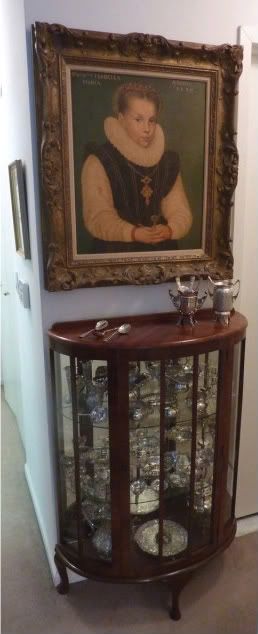
The glass front and the mirrored back along with the shiney reflective surface of the sterling and plate within the vitrine create a gorgeous visual impact and an intriguing display.

My cabinet of silver also illustrates an important point regarding the display of your collection. The setting of for your objects is just as essential as the pieces in the collection itself. If my demilune vitrine had a solid instead of a mirrored back, the silver would have still looked beautiful, but the visual impact would have been much less. The reflections produced by the silver, the mirrored back and the glass create a strong visual play for the eye and enhance the presentation of the silver.
Also, for example, you could display a collection of antique pottery in a Welsh cupboard to achieve a rustic, country look, but those same pieces of pottery displayed on modern dark cube shelves in a wall grouping would give a decidely more contemporay art feel as if each piece were an individual sculpture.
Lighting is also important. If you can use uplights or spot lights to highlight a collection then do so. Think also of a lighted display cabinet which can produce a pleasing effect and draws your eye to the objects within that piece of furniture.
Furthermore, think of other areas in your house to display antique and vintage objects. Use a large, round table in a foyer. A group of antique boxes perhaps some on stands to have different heights could be quite beautiful or a collection of antique brass- candlesticks, vases etc. could produce a charming vignette. Or perhaps a back hallway is perfect for a presentation of plates mounted on the wall or a collection of antique dog prints or mirrors of different shapes and sizes.
The bathroom is also a great space in which to exhibit a small collection. Here is the bathroom of a client with a small grouping of various types of collectible dogs. This display makes a strong visual impact and imbues the bathroom with a sense of fun and whimsy.

Wall groupings are often the best way to display certain collections that are suited to be hung because they do not take up as much space as for example a cabinet. Antique plates and platters make a superb wall exhibition. But don't use tension/spring hangers to hang plates on the wall as they can cause stress fractures and rim chips. Instead use brass ball plate hangers that come in a variety of sizes to fit the dimensions of your specific plate. These hangers are simple and effective and do not compete with the beauty of your plate or platter.
In the bedroom of my apartment, I had a large blank wall that I decided to fill with my collection of late 19th century (1880's) English Aesthetic transferware pottery in brown and black.
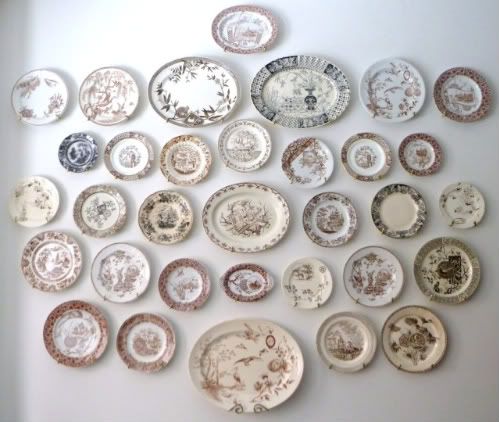
Aesthetic pottery was heavily influenced by the arts of Japan in its use of asymmetry, overlapping insets with different subjects, geometric patterns and motifs of flora and fauna. A good example of Aesthetic pottery is this 13" brown transferware platter in a pattern called Fan circa 1880 by Bovey Tracey Potteries. It demonstrates many of the hallmarks of the Aesthetic style.

Also, in my wall grouping are earlier mid 19th century transferware plates influenced by Chinese subjects. This type of plate is often categorized as chinoiserie. Here is a good example, a 6" black transferware plate in the Jeddo pattern by W. Adams & Sons, circa 1849.

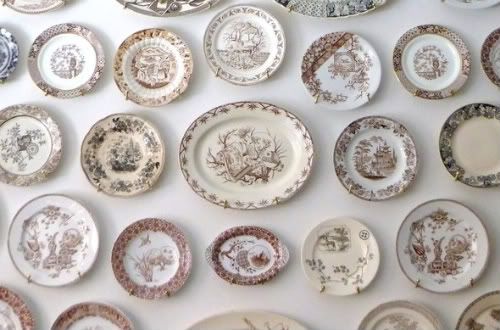
You may have noticed that in my large wall grouping of 33 plates and platters, I have used 3 sets of pairs. Often having 2 of the same item in a grouping of a collection is not a good idea. If you have only 5 plates on a wall and 2 are the same, the result is not as pleasing as 5 distinct pieces. However, in a large display such as mine with different size items, having a few pairs can help create a structure and cohesiveness to the whole presentation. I also have 6 pieces on the wall in different shapes and sizes, but all in the same Aesthetic pattern called Cairo which features Near East/Egyptian motifs with Japanesque styling. Notice the mosque in the unfurling scroll in this 10" platter.

So, if you have a collection of antiques or vintage items group them together for the greatest visual impact. You will enjoy seeing your collection together and your guests will derive great pleasure from seeing your beautiful treasures as well. Remember to edit your collection, consider the amount of space you need for your exhibition so it does not look crowded or cluttered, decide what your collection will be shown on or in and what feeling that will impart on the viewer, use unusual spaces such as a bathroom or back hallway for your display and finally consider lighting so that your collection can be clearly viewed and visually heightened.
If you are looking for a particular antique or vintage item contact me at [email protected] and I can find it for you. Perhaps, you would like to start collecting silver, but do not know where to start. Or maybe you have a flatware pattern from your grandmother, but you need more serving pieces; I can find it for you. Or would you like to assemble a 19th century transferware pottery collection for a country hutch? Contact me and I can be of assistance. Also, if you need help grouping collection(s) that you already have for maximum effect and are in the NYC/New Jersey area, I able to come to you and arrange your accessories.
Happy New Year!
Kelly T Keating
Holiday Decorating and Entertaining with Your Antiques and Collectibles
by Kelly Keating on 12/14/10
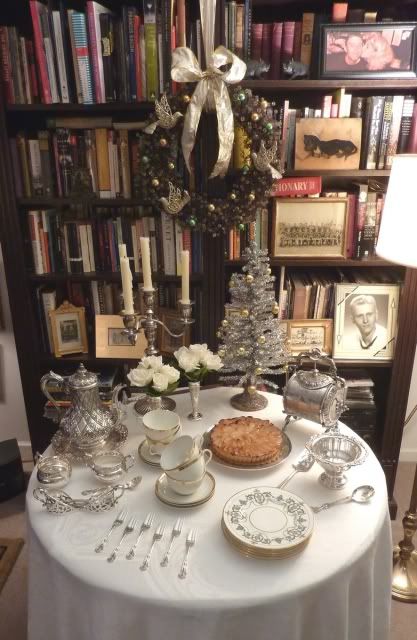
The approaching holidays are a wonderful opportunity to use your antiques and collectibles to both decorate your home and elegantly entertain your friends and family. Recently, I had several friends over for coffee and dessert after we all went to see the Rockefeller Center Christmas Tree and the holiday windows along 5th Avenue in New York City. When I invite friends or family over for dinner or just dessert (and not just for the holidays), I always try to make it a stylish affair by using my antique silver and china. Don't be afraid to use your antique and vintage pieces to entertain; your guests will always appreciate it. Even a simple dessert on a beautiful antique porcelain plate with a sterling or plate fork makes for a charming experience for those friends and family attending.
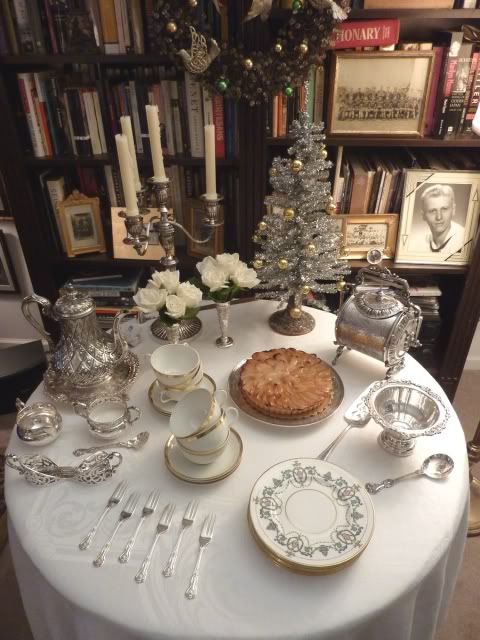
For this recent dessert party where I served a simple apple tart with fresh whipped cream, I used a set of Minton porcelain dessert plates circa 1913 featuring urns, swags and scrolls in greens, blues, pinks and a touch of yellow with gold rims.
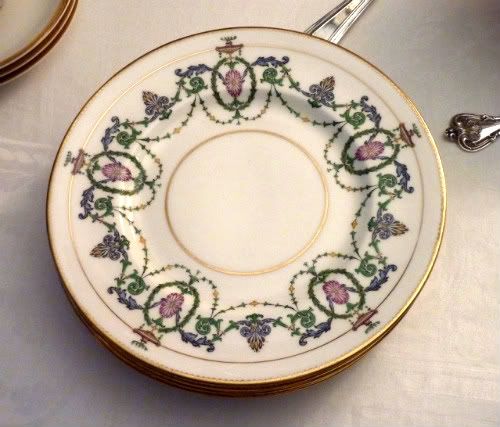
To complement the Minton plates, I set out English silverplate pastry forks circa 1920-1930 in the traditional and classic Kings pattern with its shell motif.

To serve the coffee, I used a beautiful and intricate repousse English silverplate coffeepot about 1880 by Martin Hall & Company, Sheffield. The four light candelabra is also English silverplate engraved on the bottom 1884 and made by Horace Woodward and Company, Birmingham. Completing the table holloware is an English silverplate biscuit barrel about 1880-1890 by James Deakin & Sons, Sheffield that I filled with shortbread biscuits.
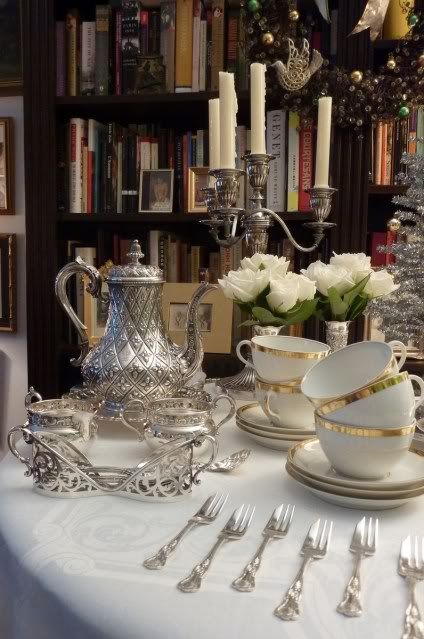
The table was simply decorated with a old silver foil tree decorated with vintage gold mini glass ornaments. Along with the tree, a pair of English sterling bud vases hallmarked William Comyns, London, 1902 were filled with fresh white roses. The foil tree complemented the bud vases and the other silver holloware on the table and the whole table setting was set off strikingly against the vintage white damask cloth used to cover the table.

Above the table hanging from the bookcase was a new wreath adorned with vintage green and gold glass ornaments, silver glitter birds and hung with a silver ribbon edged in gold.
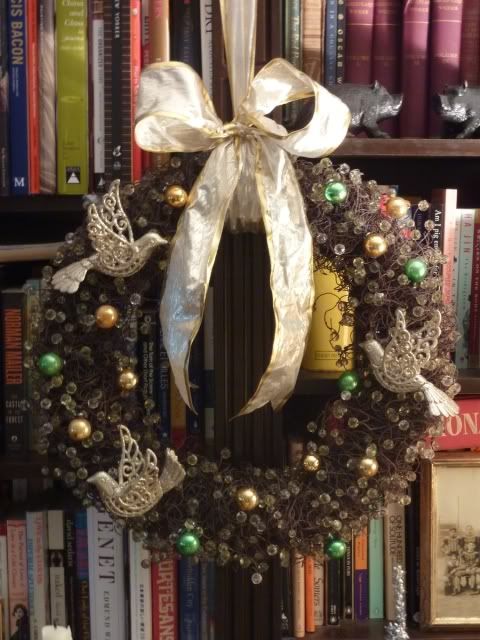
At this time of year, it is quite easy to find old glass ornaments at antique shops and flea markets. They usually have a lovely, slightly worn patina which will give a warm look and feel to your holiday decorating. And don't be afraid to combine vintage holiday ornaments with new ones as I did; they work quite well together.
Furthermore, Christmas decorations do not have to be limited to a red and green color scheme. Choose colors that work well with your particular room setting. Instead of a traditional Christmas red use a deep, rich burgundy if that works well with your decor or perhaps a raspberry or plum color best fits your surroundings. And of course there are a myriad of shades of green from which to choose. Remember that any decor color scheme from traditional to modern can be wonderfully decorated with metallics such as my use of silver and gold (with the additon of white) because they are in fact neutrals and will work with all colors. Even bronze and copper can work in a variety of room settings.

I continued my holiday color palette of gold, silver and white in the living room area of my apartment. I decorated the sideboard with a green velvet and gold runner on which I placed a large Petrus Regout chinoiserie bowl circa 1930 filled with vintage silver glass ornaments.
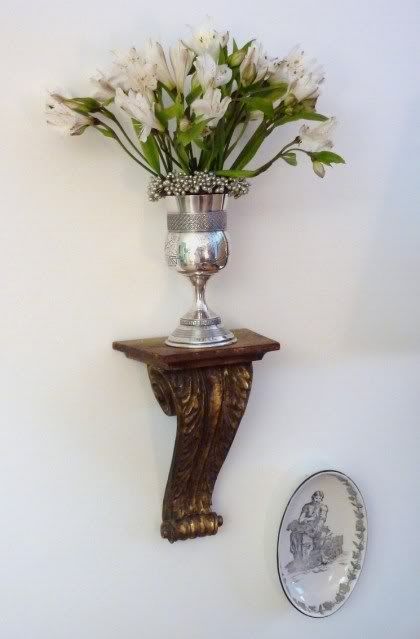
On the gilt wood shelves on either side of the large gold frame above the sideboard, I placed a pair of aesthetic silverplate goblets circa 1880 by the Meriden Silver Plate Company. The goblets were topped with a vintage glitter silver berry ring and filled with white alstromeria. (These goblets are for sale. Go to the For Sale page for details.)
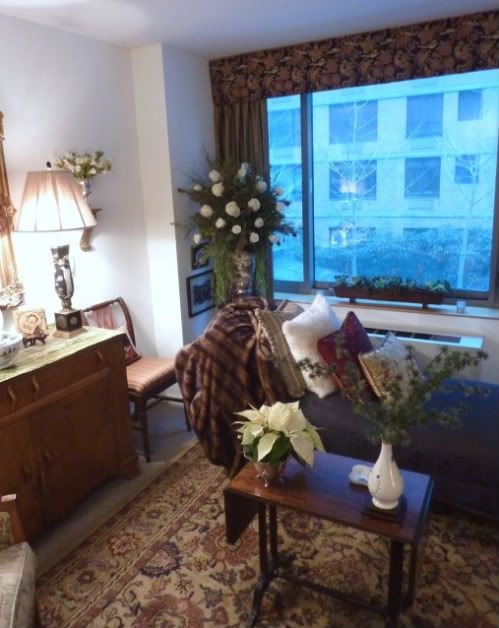
The coffee table had a creamy white pointsettia in a circa 1900 footed nut bowl by the Rockford Silverplate Company and some faux pine branches filled a turn of the century English transferware vase in a chinoiserie pattern. Behind the chaise, a mixed bouquet of faux cedar, long needle pine, weeping pine and creamy white roses in a modern Chinese vase completed the look and provided a dramatic focal point for the room.
If you have antique or vintage silver flatware and holloware as well as china, use it for your holiday entertaining and throughout the year; I guarantee that your guests will enjoy it and appreciate being served on fine and interesting pieces with the patina of age and history. Take antique items and use them for a new purpose as I did turning a pair of goblets into a vases.
Add vintage Christmas items such as aged, glass ornaments, decorative foil trees and even vintage holiday figures such as Santas and snowmen to your usual decorating. Adding such items will give your Christmas decorations a more collected, interesting and unique look, full of history, and will enhance the antiques in your setting if you have them. For example, her is a picture of a client's kitchen hutch filled with a collection of Pink Tower transferware by Spode circa 1900-1920.
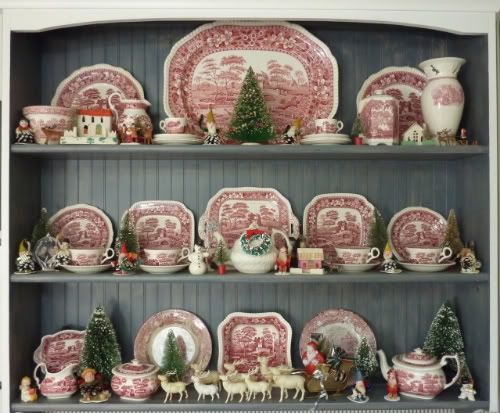
Set amongst the pottery are vintage Christmas items- bottle brush trees laden with snow, Christmas elves and snowmen with pinecone bodies, decorated cardboard houses and a vintage plastic Santa in a sleigh pulled by celluloid reindeer. The Pink Tower collection and the vintage holiday pieces enhance each other through age and color, creating a whimsical and charming holiday antique vignette.
Contact me at [email protected] if you are looking for a particular antique or vintage item for yourself, for a gift or to enhance your Christmas decorating or perhaps a special new piece for entertaining.
Happy Holidays! Happy New Year!
Kelly T Keating
A Wall Grouping in a Master Bedroom
by Kelly Keating on 12/05/10
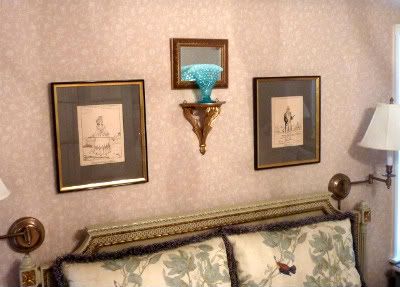
A client in Short Hills, New Jersey was redoing her master bedroom and asked for help in creating a focal point over the bed as it is the first area of the room you see when you enter the room. The room had a neutral, biscuit colored wallpaper with an overall floral pattern in a faint creamy white; the fabrics were also creamy white with touches of blue and bronze as seen in the fabric of the pair of decorative pillows for the bed.
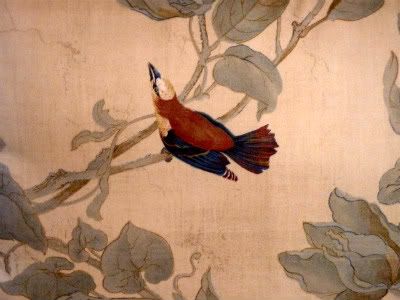
First, I suggested a headboard, not to big, but with some color to complement the fabrics in the room and direct the eye to the focal wall with color. In a local auction house, I found a French 1930's/1940's headboard, substantial, but not overwhelming in an aged blue/green color. It had wonderful gilded accents for that touch of luxury and glamour in a master bedroom.
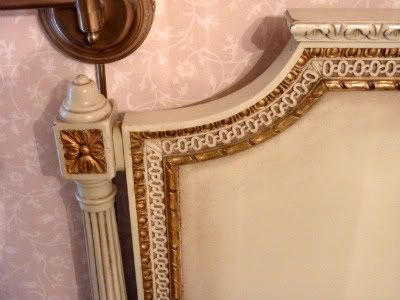
For over the new headboard, I found and hung a vintage pair of his and her golf prints, depicting a woman in late 18th century costume and a man in 19th century costume.
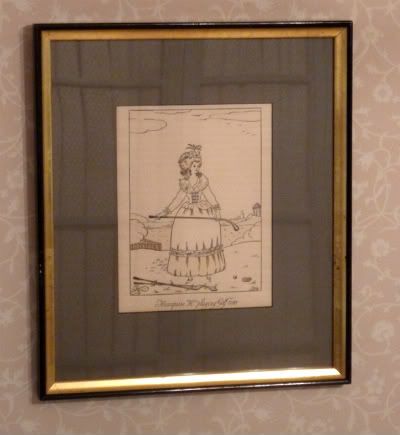
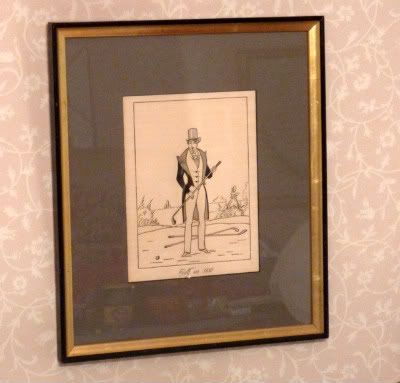
The client's husband is an avid golfer and these pictures wer a nice acknowledgement of his interests in the room they share. The gold in the frames of these prints spoke to the headboard and the black of the frames grounded the images and set them off against the paler background wallpaper in a very graphic way.
Between the prints, I used an Italian gilt wood shelf which I found to give the wall some dimension and added luxury. Above the shelf I hung a small, bevelled mirror in a gilt frame tath the client already had. On the shelf a vintage 1940's Fenton glass hobnail fan vase in blue was placed. The client has a collection of this type of glass. The blue of the vase brought the color in the room's fabrics up onto the more neutral wallpaper and the shiny glass reflected nicely int the mirror behind it, drawing the eye when you enter the room.

The client was quite pleased with the results and it finished the room with a beautiful focal point. She can now add fresh flowers from time to time in the fan vase to further enhance the look.
If you are looking for vintage or antique prints, engravings, lithographs or paintings to adorn your walls, please contact me at [email protected] and if you need someone to hang your pictures in a decorative manner, I can also assist you. Go to the "Services" page of my website for further details.
Here is a picture of a wall grouping in my apartment- an elegant mixture of paintings, engravings, photographs and prints- all vintage and antique...
